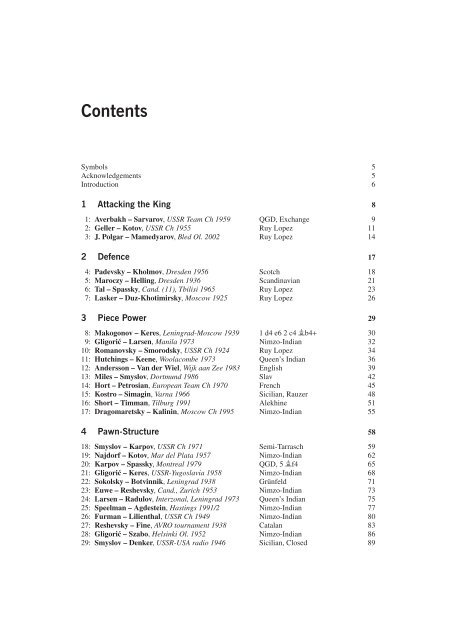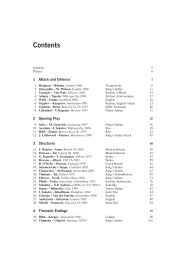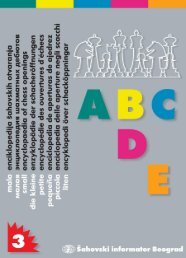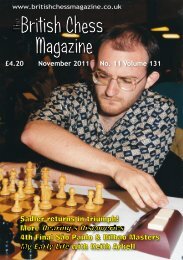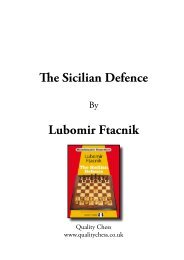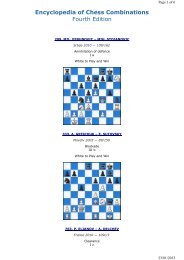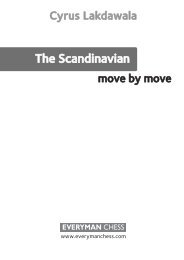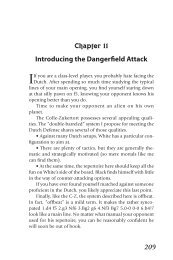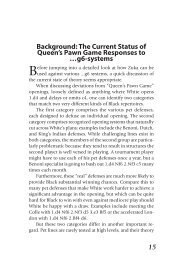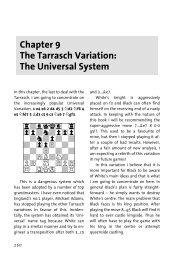Create successful ePaper yourself
Turn your PDF publications into a flip-book with our unique Google optimized e-Paper software.
CONTENTSContentsSymbols 5Acknowledgements 5Introduction 61 Attacking the King 81: Averbakh – Sarvarov, USSR Team Ch 1959 QGD, Exchange 92: Geller – Kotov, USSR Ch 1955 Ruy Lopez 113: J. Polgar – Mamedyarov, Bled Ol. 2002 Ruy Lopez 142 Defence 174: Padevsky – Kholmov, Dresden 1956 Scotch 185: Maroczy – Helling, Dresden 1936 Scandinavian 216: Tal – Spassky, Cand. (11), Tbilisi 1965 Ruy Lopez 237: Lasker – Duz-Khotimirsky, Moscow 1925 Ruy Lopez 263 Piece Power 298: Makogonov – Keres, Leningrad-Moscow 1939 1 d4 e6 2 c4 Íb4+ 309: Gligori‡ – Larsen, Manila 1973 Nimzo-Indian 3210: Romanovsky – Smorodsky, USSR Ch 1924 Ruy Lopez 3411: Hutchings – Keene, Woolacombe 1973 Queen’s Indian 3612: Andersson – Van der Wiel, Wijk aan Zee 1983 English 3913: Miles – Smyslov, Dortmund 1986 Slav 4214: Hort – Petrosian, European Team Ch 1970 French 4515: Kostro – Simagin, Varna 1966 Sicilian, Rauzer 4816: Short – Timman, Tilburg 1991 Alekhine 5117: Dragomaretsky – Kalinin, Moscow Ch 1995 Nimzo-Indian 554 Pawn-Structure 5818: Smyslov – Karpov, USSR Ch 1971 Semi-Tarrasch 5919: Najdorf – Kotov, Mar del Plata 1957 Nimzo-Indian 6220: Karpov – Spassky, Montreal 1979 QGD, 5 Íf4 6521: Gligori‡ – Keres, USSR-Yugoslavia 1958 Nimzo-Indian 6822: Sokolsky – Botvinnik, Leningrad 1938 Grünfeld 7123: Euwe – Reshevsky, Cand., Zurich 1953 Nimzo-Indian 7324: Larsen – Radulov, Interzonal, Leningrad 1973 Queen’s Indian 7525: Speelman – Agdestein, Hastings 1991/2 Nimzo-Indian 7726: Furman – Lilienthal, USSR Ch 1949 Nimzo-Indian 8027: Reshevsky – Fine, AVRO tournament 1938 Catalan 8328: Gligori‡ – Szabo, Helsinki Ol. 1952 Nimzo-Indian 8629: Smyslov – Denker, USSR-USA radio 1946 Sicilian, Closed 89
4 50 ESSENTIAL CHESS LESSONS30: Matulovi‡ – Fischer, Vinkovci 1968 Sicilian, Najdorf 9231: Filip – Szabo, Bucharest 1953 QGD, Exchange 9532: Portisch – Kasparov, Skellefteå 1989 QGD, Exchange 9733: Portisch – Radulov, Budapest 1969 Dutch 10034: Hodgson – Short, British Ch 1987 Bird 10335: Golombek – Fuderer, Zonal, Munich 1954 King’s Indian 10636: Shamkovich – Nezhmetdinov, USSR Ch 1961 King’s Indian 10837: Flohr – Suetin, USSR Ch 1950 King’s Indian 11138: Epishin – Polugaevsky, Tilburg 1993 Queen’s Indian 11439: Levenfish – Lisitsyn, Moscow 1935 English 11640: Dragomaretsky – D. Maximov, Moscow 2005 English 11941: Uhlmann – Bönsch, Halle 1976 English 12242: Alatortsev – Khavin, Moscow 1949 QGD, Orthodox 1255 Endgame Themes 12843: Euwe – Van Doesburgh, Dutch Ch 1938 QGD, Orthodox 12944: Schlechter – Rubinstein, San Sebastian 1912 French 13345: Timman – Ree, Amsterdam 1984 QGD, Orthodox 13646: Yanofsky – Pinkus, Ventnor City 1942 QGD, Orthodox 13947: Plater – Botvinnik, Moscow 1947 Sicilian, 2 Ìe2 14348: Ribli – Grünfeld, Interzonal, Riga 1979 QGD, Tarrasch 14649: Gulko – Kremenietsky, Moscow Ch 1983 Sicilian, Closed 15050: Ciocaltea – Unzicker, Moscow 1956 Ruy Lopez 154Index of Players 158Index of Openings 159
14 50 ESSENTIAL CHESS LESSONSGame 3J. Polgar – MamedyarovOlympiad, Bled 2002Ruy Lopez (Spanish), OpenThe previous two games have both featured attacks on castled kings. Here we see the black kingtrapped in the centre of the board. In open positions, this is generally a highly dangerous situationfor the king, as he is exposed to the full attack of the enemy pieces, down the open central files. Thekey feature of such attacks is to retain the initiative, and not allow the defender any time to evacuatehis king from the danger zone, or to bring additional pieces into the defence. The attacker must operatewith continual threats, to keep the defender off-balance.1 e4 e5 2 Ìf3 Ìc6 3 Íb5 a6 4 Ía4 Ìf6 50-0 (D)Br+lwkv-t+pzp+pzpp+n+-s-++-+-z-+-L+-+P+-++-+-+N+-PZPZ-ZPZTNVQ+RM-5...Ìxe4This move characterizes the Open Defenceto the Ruy Lopez, championed in the early 20thcentury by the great German player and teacher,Siegbert Tarrasch. In the Closed Defence, whichwe saw in Game 2, Black plays 5...Íe7 andsubsequently supports his centre by ...d6. Thishas the drawback of shutting in Black’s king’sbishop, and generally cramping his position. DrTarrasch abhorred cramped positions, and generallycondemned any opening variation whichinvolved such a position. Instead, in the Open,Black secures more space and open lines for hispieces, but this comes at the cost of some weakeningof his pawn-structure. Over the decades,the line has generally been less popular than theClosed system, but has always had a core groupof die-hard supporters. Former world championMax Euwe was one such, while in more recenttimes, Viktor Korchnoi has upheld the variationin numerous games.6 d4 b5Capturing another pawn with 6...exd4 is extremelyrisky. After 7 Îe1 the central positionof the black king leads to problems.7 Íb3 d5 8 dxe5 Íe6 (D)Wr+-wkv-t+-z-+pzpp+n+l+-++p+pZ-+--+-+n+-++L+-+N+-PZP+-ZPZTNVQ+RM-This is the basic position of the Open Defence.Black’s minor pieces have more activitythan in the Closed line, but his queenside pawnsare somewhat weak and over-extended. If hecan achieve the advance ...c5 in favourable circumstances,Black can potentially look forwardto a splendid game, but this is not easy toachieve against accurate play by White.9 Ìbd2 Ìc5 10 c3 d4 11 Ìg5!A truly striking move, offering a piece sacrifice.White’s idea is to answer 11...Ëxg5 with12 Ëf3, when Black cannot adequately defendhis c6-knight in view of the follow-up 13 Íd5.In fact, this is all well-known theory, with 11Ìg5 having first been played in a Karpov-Korchnoi world championship game, as far backas 1978.11...Íd5? (D)Mamedyarov hopes to avoid the complicationsresulting from accepting the piece, but
ATTACKING THE KING 15this move is a serious error in view of White’sreply. Much midnight oil has been expended onvariations beginning 11...Ëxg5 12 Ëf3 0-0-0,although practical experience suggests thatWhite’s chances are preferable. These days,opening fashions change rapidly, but at thetime of writing, Black tends to be avoiding thiswhole line and preferring 10...Íg4, rather than10...d4.W12 Ìxf7!This sacrifice traps the black king in the centre,where it will be subject to a ferocious attack.12...Êxf7The only move, since after 12...Íxf7, Whiteimmediately regains his piece by 13 Íxf7+Êxf7 14 Ëf3+ and 15 Ëxc6, remaining withan extra pawn and the black king trapped in thecentre.13 Ëf3+ Êe6 (D)Again forced, so as to defend the d5-bishop.White now has to consider how to prosecute theattack further. Clearly, it will be necessary tobring up some further reserves in due course,but first, Polgar forces Black to make a choicewith his king.Wr+-wkv-t+-z-+pzpp+n+-+-++pslZ-S--+-z-+-++LZ-+-+-PZ-S-ZPZT-VQ+RM-r+-w-v-t+-z-+-zpp+n+k+-++pslZ-+--+-z-+-++LZ-+Q+-PZ-S-ZPZT-V-+RM-14 Ëg4+ Êf7?!The alternative retreat 14...Êe7 is better, butWhite still has a near-decisive attack. A previousgame Svidler-Anand had continued 15 e6!,and White soon achieved a winning advantage.15 Ëf5+ Êe7If the king goes to e8 or g8, the reply 16 e6wins immediately, since Black cannot defendboth the mate threat on f7 and the attackedbishop on d5.16 e6 (D)Br+-w-v-t+-z-m-zpp+n+P+-++psl+Q+--+-z-+-++LZ-+-+-PZ-S-ZPZT-V-+RM-The most important thing in such positions isnot to give the defender any breathing space,and Polgar demonstrates this admirably. Herlast move attacks the d5-bishop, as well as liningup a possible check on f7 at some point. Dependingon how Black replies, she intends tobring the d2-knight into the attack, in turn openingthe way for the c1-bishop to give a potentiallydeadly check on g5. If Black captures thee6-pawn, this will open the e-file, and allowWhite’s rook to become very active from e1.This is a typical example of how the initiativeflows in such positions – by constant threats,the attacker deprives the defender of time to unravelhis position and bring additional units intothe defence.16...Íxe6As noted above, this opens an important additionalline against the black king, but Blackhad to do something about his attacked bishop.The alternative was 16...Ìxb3, which wouldeliminate one of the attacking pieces. However,this exchange also eliminates one of Black’sdefensive pieces, and after the reply 17 Ìxb3,the white knight would join the attack, and thec1-bishop would also be ready to jump in.Polgar continues the variation by 17...Íxe6 18
16 50 ESSENTIAL CHESS LESSONSÎe1 (threatening 19 Íg5+) 18...Ëc8 19 Íg5+Êd6 20 Íf4+! Êe7 (by these last two moves,White has effectively developed the bishop forfree) 21 Ìc5, with an overwhelming attack;e.g., 21...Ìd8 22 Îxe6+! and 23 Îe1, winning.17 Îe1! (D)A very striking move, typical of such positions.White could regain the piece, with check,by simply 17 Ëxc5+, but this would weakenthe force of the attack after 17...Ëd6.Br+-w-v-t+-z-m-zpp+n+l+-++ps-+Q+--+-z-+-++LZ-+-+-PZ-S-ZPZT-V-T-M-Polgar prefers to strengthen the attack bybringing another piece into action. In such positions,as we have emphasized before, it is notthe nominal piece-count that matters, but thenumber of pieces that are active in the criticalsector of the board. Both of Black’s rooks, forexample, are dormant in the present position.17...Ëd6 18 Íxe6 Ìxe6 19 Ìe4Continuing the ‘no respite’policy. The knightjumps into the attack and opens the diagonal ofthe c1-bishop, all with tempo.19...Ëe5 20 Íg5+ (D)Another white piece joins the attack, andBlack must now lose his queen. If 20...Ìxg5,then 21 Ìxg5, and if 20...Êe8, 21 Ìf6+. Blackprefers the third option.20...Êd7 21 Ìc5+ Íxc5Or 21...Ëxc5 22 Ëxe6#.22 Ëf7+Once again eschewing material gain to pursuethe attack to its logical conclusion.22...Êd6B22...Íe7 23 Îxe5 is no improvement forBlack.23 Íe7+ (D)Br+-+-v-t+-z-m-zpp+n+n+-++p+-wQV--+-zN+-++-Z-+-+-PZ-+-ZPZT-+-T-M-r+-+-+-t+-z-VQzpp+nmn+-++pv-w-+--+-z-+-++-Z-+-+-PZ-+-ZPZT-+-T-M-1-0Black resigned in view of 23...Ìxe7 24 Îxe5Êxe5 25 Îe1+, while fleeing with 23...Êd5leads to a nice mate after 24 Ëf3+ Êc4 25 b3#.The Essential Lessons• A king which is trapped in the centre can bevulnerable to a devastating attack.• From the attacker’s viewpoint, it is frequentlyworth a sacrifice in order to trap the enemyking in the centre.• As with all attacks, success depends on gettingmore pieces into action in the crucialsector of the board.• It is frequently better to bring additionalpieces into the attack than to take material(17 Îe1!).


